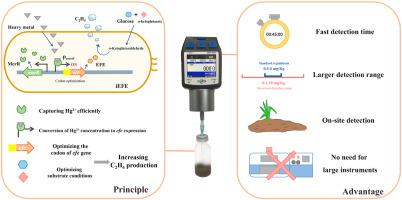Biosensors and Bioelectronics ( IF 10.7 ) Pub Date : 2020-09-28 , DOI: 10.1016/j.bios.2020.112660 Yanger Liu , Mingzhang Guo , Ruoxi Du , Jiani Chi , Xiaoyun He , Zixin Xie , Kunlun Huang , Yunbo Luo , Wentao Xu

|
As optical reporting elements, fluorescent proteins are extensively used in whole-cell microbial biosensors. However, the use of these optical reporters is limited in opaque media such as soil. This study described a method utilizing gas as a reporting signal that could be used for the rapid on-site detection of mercury in soil. In this biosensor, the MerR protein could capture mercury ions and then bind the promoter of the efe gene to initiate the synthesis of the ethylene (C2H4)-forming enzyme that produced the gas. The research showed that the mercury ion concentrations could be converted into C2H4 gas signals, which were quantified using a handheld C2H4 sensor. By optimizing the biosensor to improve its anti-interference ability in the system, it could detect mercury ion concentrations in the soil ranging from 0.2 to 20 mg/kg within 45 min, effectively reflecting whether the mercury pollution in the soil exceeded the limit standard. This study provides a simple, inexpensive, and portable method for the on-site detection of soil pollutants.
中文翻译:

气体报告全细胞微生物生物传感器系统,用于快速现场检测土壤中的汞污染
作为光学报告元件,荧光蛋白广泛用于全细胞微生物生物传感器。但是,这些光学报道分子的使用仅限于不透明的介质,例如土壤。这项研究描述了一种利用气体作为报告信号的方法,该方法可用于快速现场检测土壤中的汞。在该生物传感器中,MERR蛋白可以捕获汞离子,然后将结合的启动子EFE基因以引发乙烯(C的合成2 ħ 4) -形成酶产生的气体。研究表明,汞离子浓度可以转换为C 2 H 4气体信号,使用手持式C 2 H 4可以定量传感器。通过优化生物传感器以提高其在系统中的抗干扰能力,它可以在45分钟内检测到土壤中的汞离子浓度为0.2至20 mg / kg,从而有效地反映了土壤中的汞污染是否超过了极限标准。这项研究为土壤污染物的现场检测提供了一种简单,廉价且便携的方法。











































 京公网安备 11010802027423号
京公网安备 11010802027423号